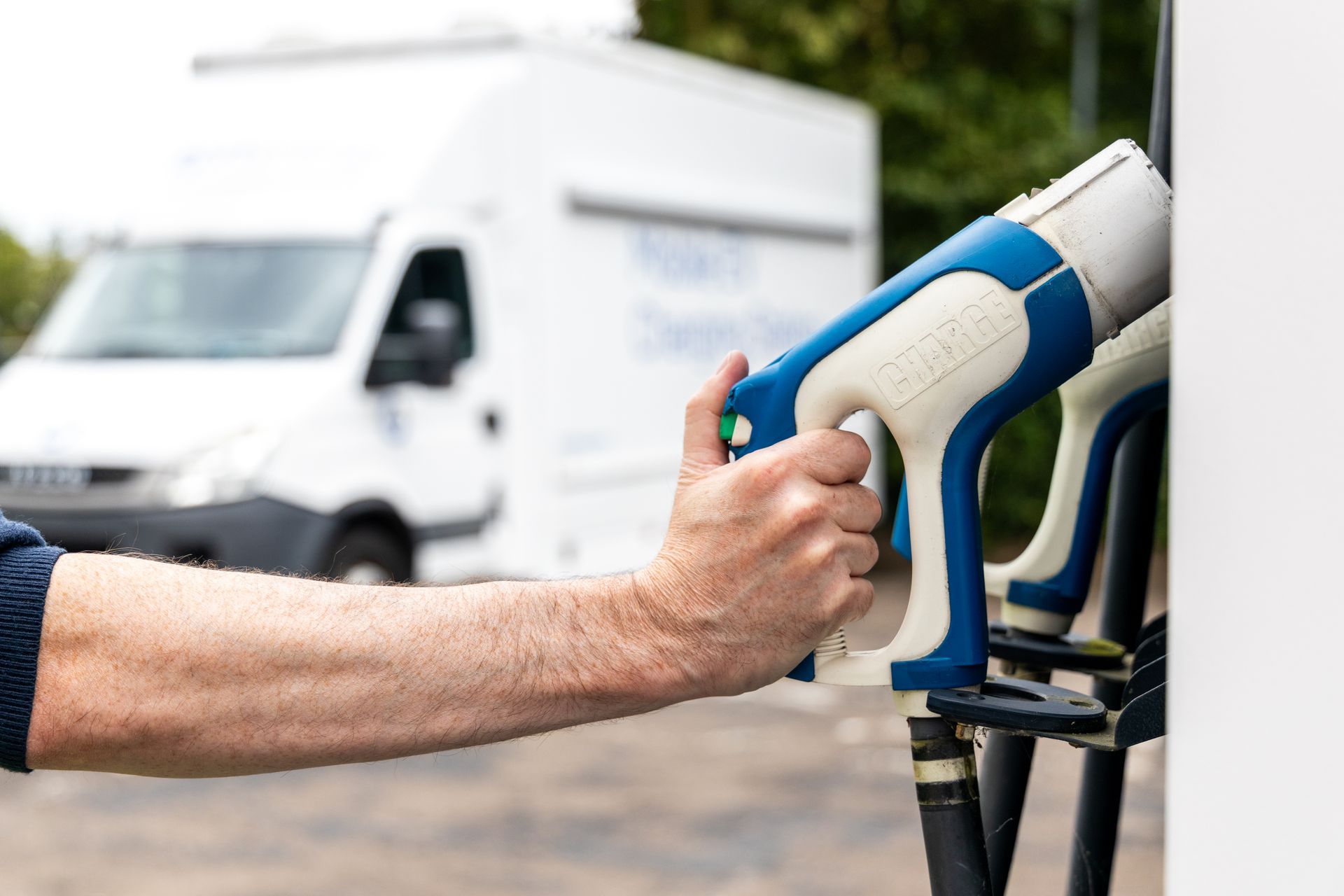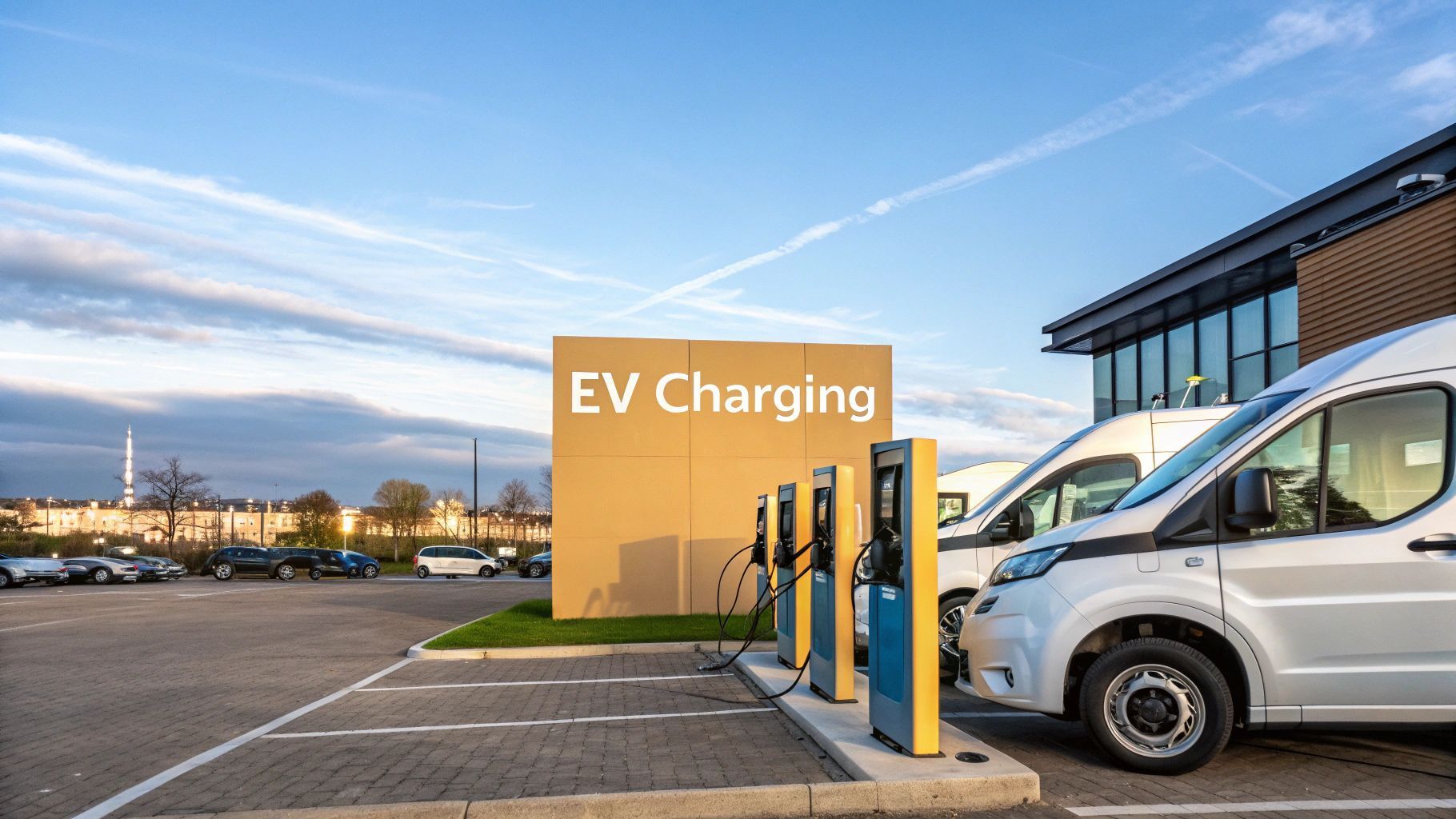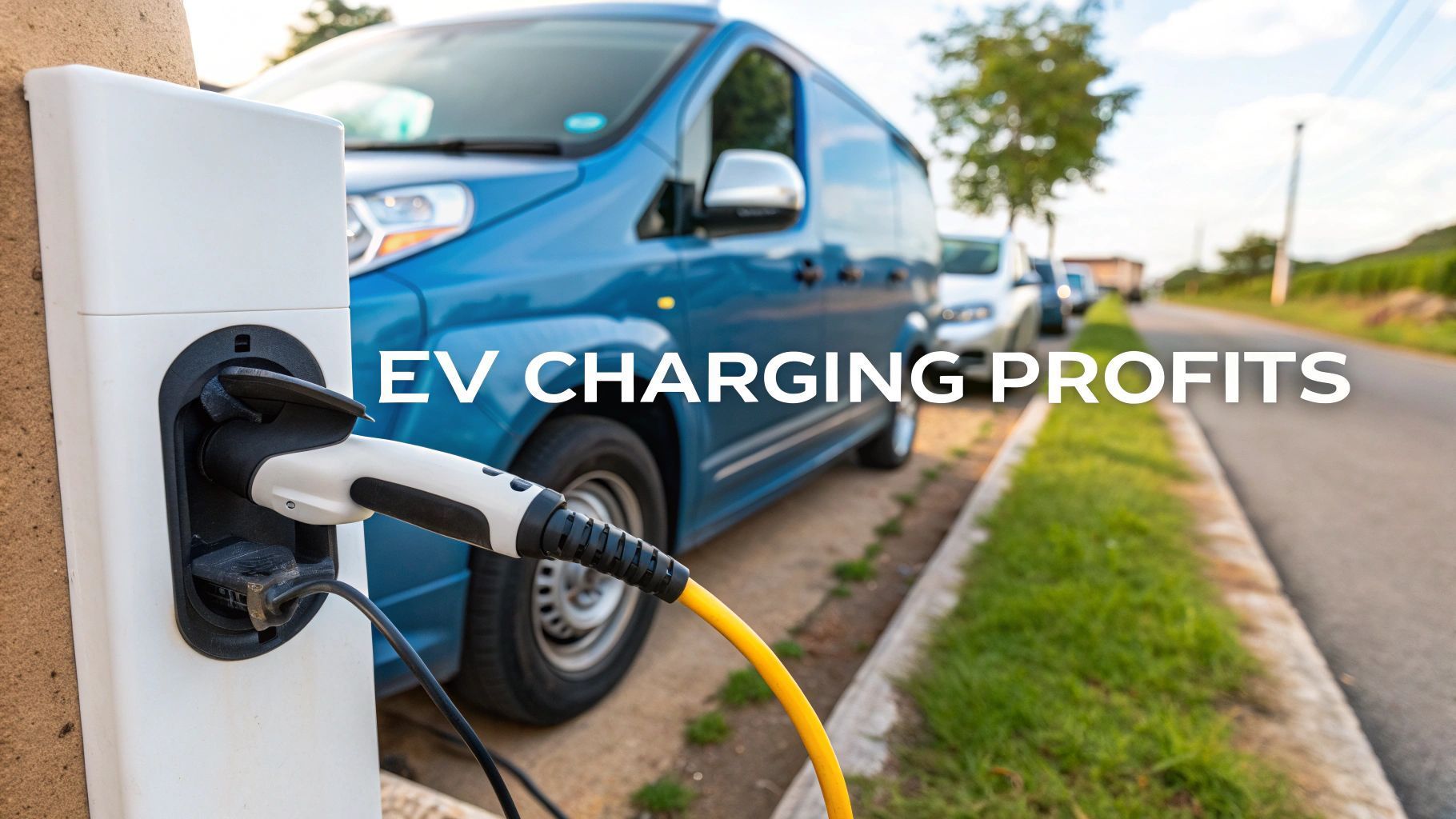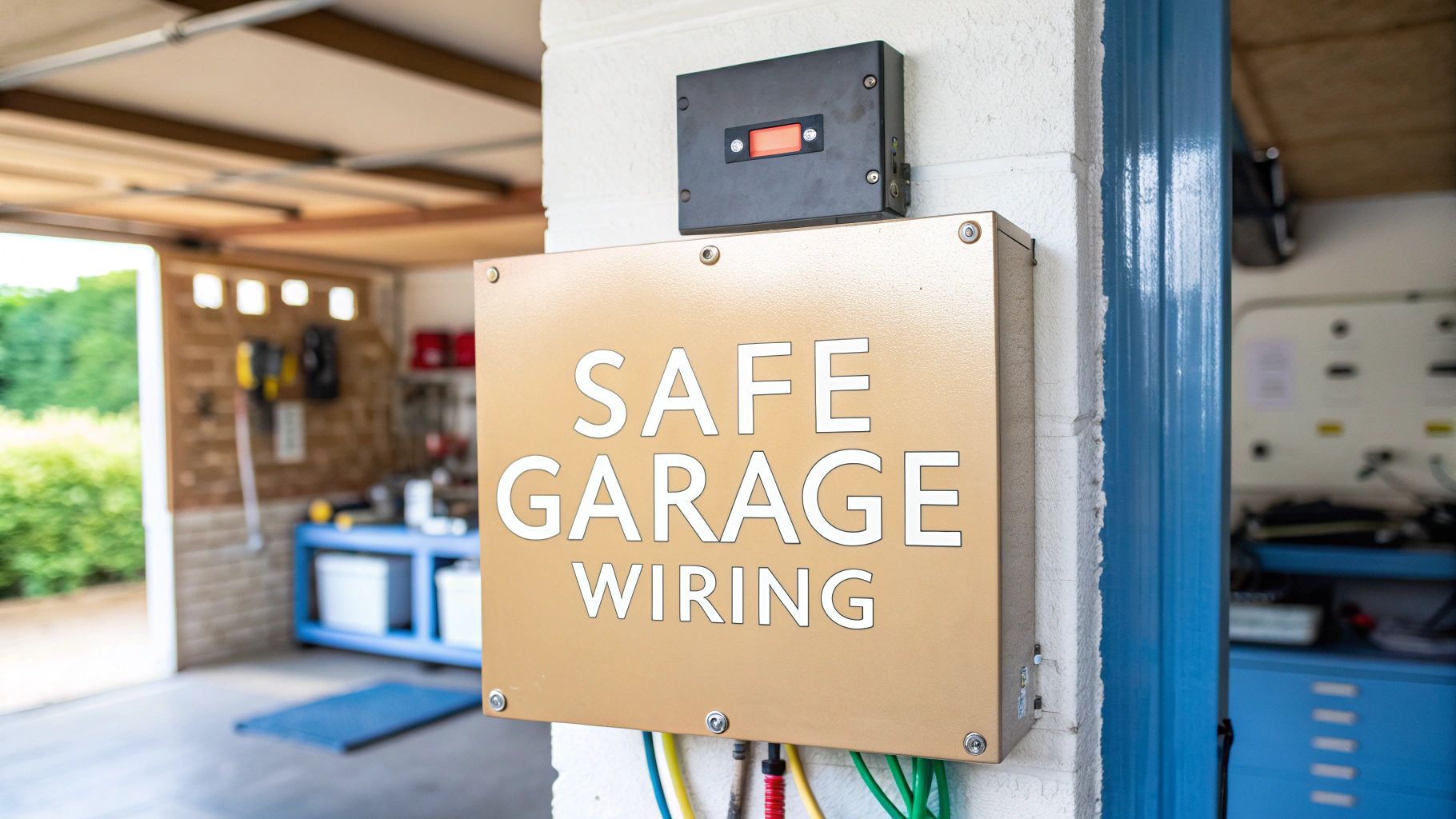Your Guide to Every EV Charger Plug in the UK
An EV charger plug is essentially the bridge between your electric car and its power source. It is what lets energy travel from the station into your battery. There are several standards— Type 2 , CCS and CHAdeMO among them—each designed for different charging speeds and use cases.
Decoding The UK’s EV Charger Plugs
In the UK the Type 2 connector has become the go-to for AC charging at home and in public. Its seven-pin layout easily handles anything from 3.7 kW up to 22 kW , covering overnight top-ups and those handy semi-rapid fills.
When you need a real power boost, the Combined Charging System ( CCS ) steps in. It builds on the Type 2 format but adds two hefty DC pins that can push up to 350 kW , slashing charge times on ultra-rapid stations.
This guide will also explore how mobile charging can unlock fresh revenue streams for operators in a competitive market.
Key Plug Variants
- Type 2 : Standard AC connector on all new EVs, found at homes, workplaces and public car parks.
- CCS (Combined Charging System) : Combines AC and DC charging in one plug for ultimate versatility.
- Type 1 and CHAdeMO : Still around on older imports, though their footprint is gradually shrinking.
The concept map below visualises the main plug types around the EV charger plug concept.
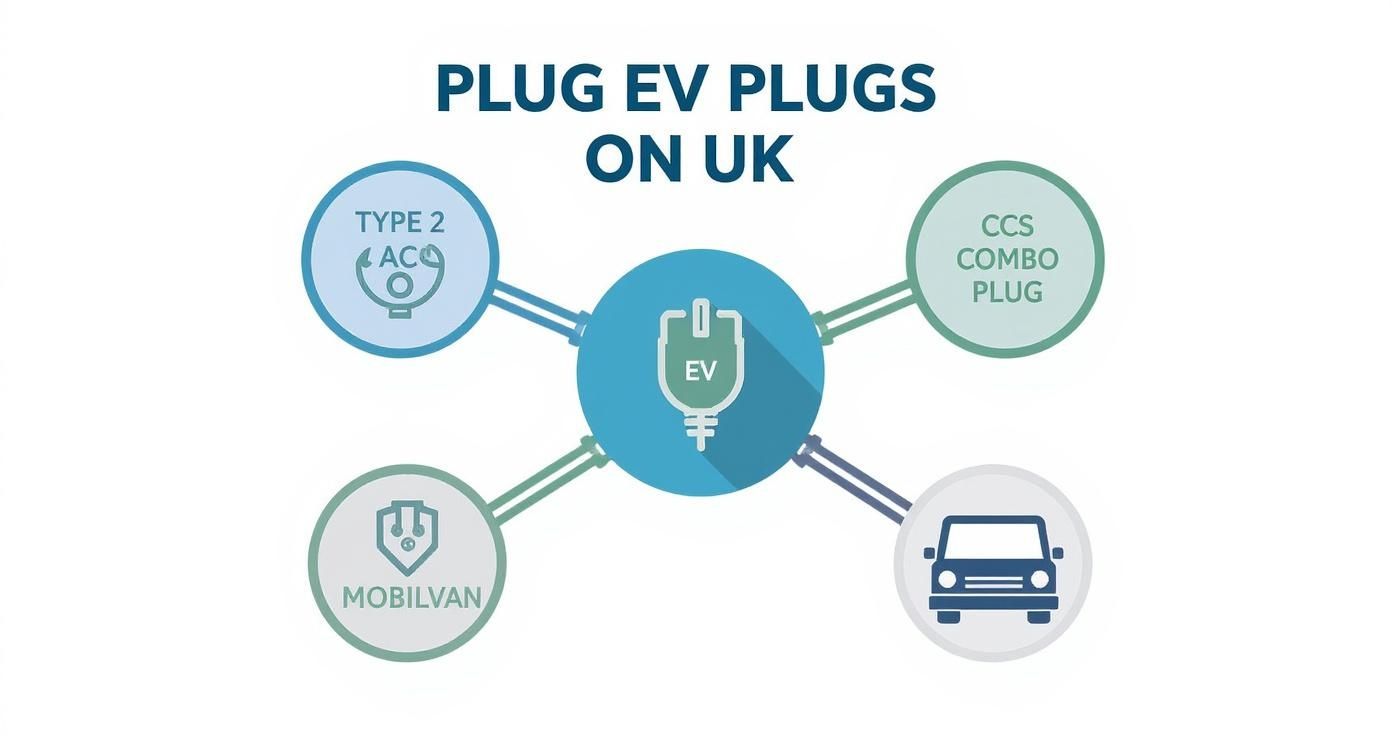
For detailed definitions check out our EV Charging Glossary.
Picture a van stocked with a high-power charger arriving wherever your car is parked. Mobile charging delivers on-demand energy in busy city centres, remote locations or at pop-up events.
It cuts wait times and keeps fleets moving, whether that is at a roadside breakdown or a depot peak.
Operators of mobile charging can tap into a growing market and generate significant income, turning a vital service into a highly profitable business.
Mobile charger operators can earn £3,000–£7,000 per month by combining call-out fees with per-kWh rates. Entrepreneurs often expand their rounds or partner with fleet managers to boost those numbers even further, creating a business that can generate a turnover of up to £80,000 per year from a single unit.
Advantages Of Mobile Charging for Operators
- High Profit Margins : The on-demand nature of the service allows for premium pricing through call-out fees and per-kWh charges.
- Scalable Revenue Streams : Build recurring income with service contracts for fleets, business parks and residential buildings.
- Flexible Business Model : Adapt your service radius and operating hours to meet shifting demand and maximise earning potential.
- Lower Initial Investment : Starting a mobile business is significantly more affordable than installing fixed public charging infrastructure.
UK EV Charger Plug Quick Reference
Below is a handy snapshot of the main plug types you will encounter in the UK, where you are most likely to see them and what power they typically deliver.
| Plug Type | Charging Method | Common Use and Location | Typical Power Output |
|---|---|---|---|
| Type 2 | AC | Home, workplace, public car park | 3.7–22 kW |
| CCS | DC & AC | Motorway services, rapid points | 50–350 kW |
| CHAdeMO | DC | Older rapid-fill stations | 50–60 kW |
| Type 1 | AC | Imports and pre-Type 2 vehicles | 3.7–7 kW |
Armed with these plug standards—whether you are charging at home, running a mobile service or planning your next road trip—you will ensure smooth energy flow and maximised returns.
Understanding Type 2 and CCS Connectors
Here in the UK and across Europe the Type 2 plug has become the undisputed standard for AC charging. It is best to think of it as the USB-C of the electric vehicle world; it is the universal connector you will find on almost every new EV and at countless public charging points, from supermarket car parks to city-centre lamp posts.
Its simple yet effective seven-pin design is perfect for handling everyday charging. This means a Type 2 connector can deliver power for a slow overnight charge at home using a 3.7kW wall box, or a faster top-up at a public 22kW destination charger. This flexibility is precisely why it was adopted as the official standard, making it the most common EV charger plug you will come across.
The Power of CCS: The All-in-One Solution
While Type 2 is perfect for AC charging the Combined Charging System (CCS) plug takes things a step further. It is not an entirely different plug but rather an enhanced version of the Type 2. The CCS design cleverly combines the standard seven-pin Type 2 socket with two large DC pins located just below it, creating a single, all-in-one port on the vehicle.
This dual-function design is ingenious. The top section handles all your regular AC charging just like a standard Type 2 but the additional DC pins unlock the ability to use the high-powered rapid and ultra-rapid chargers you see at motorway service stations. This means drivers with a CCS port have maximum flexibility.
A vehicle equipped with a CCS port can use virtually any public charger in the UK. This widespread compatibility gives drivers the freedom to travel long distances with confidence, knowing a suitable charging point is almost always nearby.
The CCS standard supports charging speeds from 50kW all the way up to 350kW and beyond. This allows an EV to gain hundreds of miles of range in as little as 20 to 30 minutes , making long journeys far more practical. It effectively gives you two charging solutions in one convenient package. For a deeper dive into which vehicles use which plugs, our guide to EV charging compatibility offers detailed information.
The integration of CCS as the European standard has been a game-changer for the public charging network. It simplifies the infrastructure for operators and removes confusion for drivers, ensuring that a new EV bought in the UK will be ready for any journey.
A Word on Legacy Plugs: Type 1 and CHAdeMO
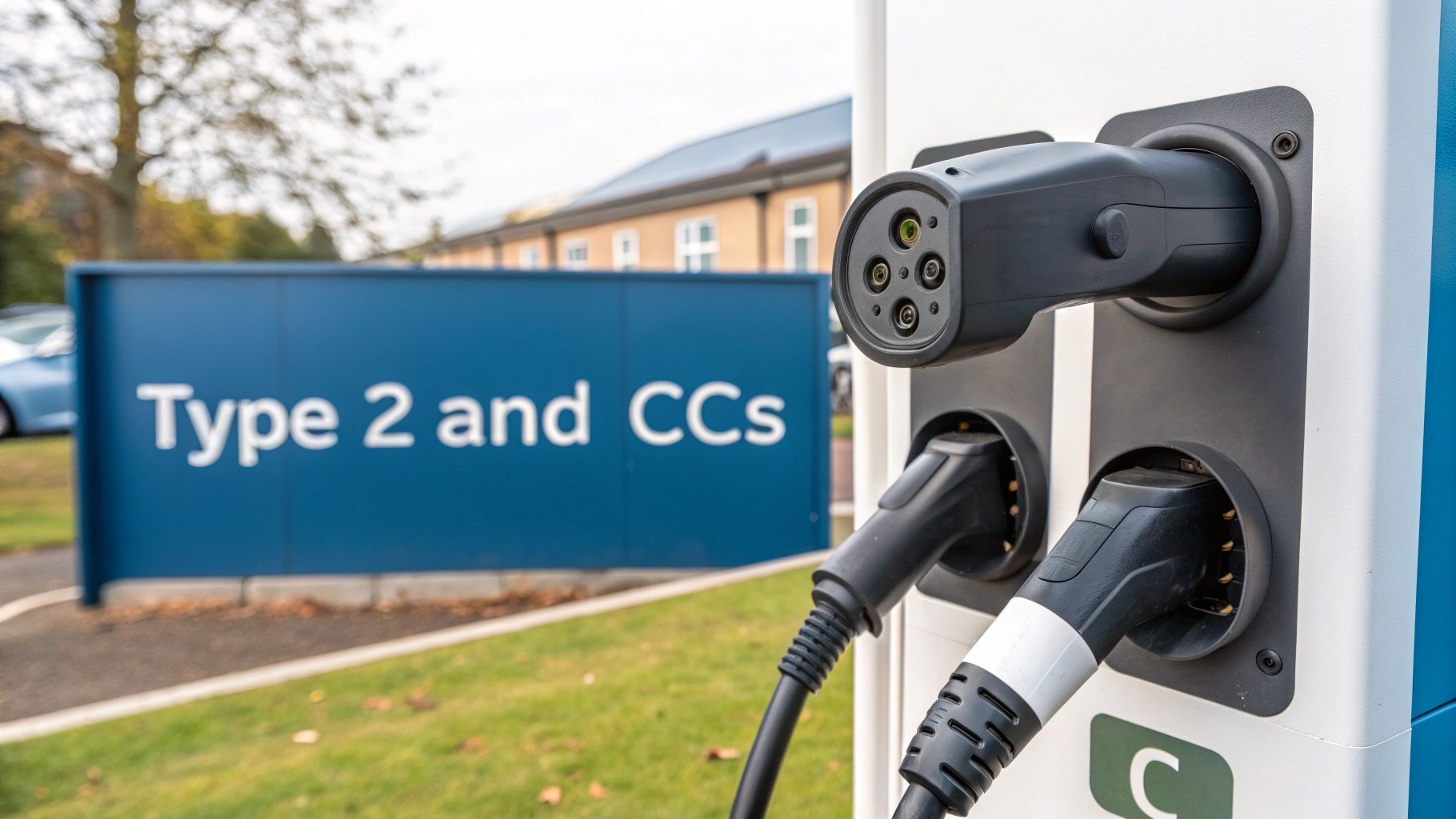
While Type 2 and CCS are the undisputed standards for new EVs here in the UK, the story does not quite end there. You will still come across a couple of older "legacy" plugs on our roads, mostly on first-generation EVs or cars imported from overseas. Knowing what they are is key to understanding the full picture of EV charging.
First up is the Type 1 plug. This five-pin connector was one of the original standards for AC charging and was common on early models like the first Nissan Leaf, as well as vehicles brought over from North America or Japan. It does the same job as a Type 2 plug but is far less common today.
Then there is the CHAdeMO plug, a true pioneer of DC rapid charging. Developed in Japan, this chunky, round connector was the go-to for a quick top-up on popular early EVs, including the Nissan Leaf and the Mitsubishi Outlander PHEV. For a long time, it was the main way to get a fast charge on a long journey.
Why Are They Being Phased Out?
It really comes down to standardisation. The industry’s shift towards a single, unified connector is the main reason these plugs are fading from view. The CCS plug simply offers a much neater solution by bundling AC and DC charging capabilities into one tidy package.
This simplifies everything from car manufacturing to the rollout of public charging infrastructure, creating a much smoother experience for most drivers.
As a result, almost all new public rapid chargers being installed in the UK are now CCS-only. While plenty of older sites still have a CHAdeMO connector alongside the CCS one, they are not usually being replaced or upgraded. The trend is clear: the number of CHAdeMO-compatible chargers has flatlined in recent years, while CCS points have multiplied exponentially.
The Reality for Drivers with Legacy Plugs
If you own a car with a Type 1 or CHAdeMO port, navigating the public network just requires a bit more forward planning. The shrinking number of compatible chargers means you cannot assume you can pull into any service station and plug in.
For drivers of older EVs, using apps like Zapmap to filter for specific plug types is not just a nice-to-have, it is essential. This simple step before you set off ensures you can map out the dwindling number of active Type 1 or CHAdeMO chargers along your route.
For Type 1 AC charging, the fix is thankfully straightforward. A Type 1 to Type 2 adapter cable is a must-have accessory, allowing you to connect your car to the thousands of standard Type 2 public charge points.
However, when it comes to rapid charging, it is a different story. Adapting between DC standards like CHAdeMO and CCS is technically far too complex for a simple cable, so you are limited to finding a native CHAdeMO unit to get that fast charge.
Connecting Plug Types to Charging Speeds
The type of plug your EV uses has a huge impact on how quickly you can get back on the road. Understanding this connection is key to making the most of your electric car, whether you are topping up overnight or grabbing a quick charge on a long drive. The difference between slow AC charging and ultra-rapid DC is massive.
To put it in perspective, think of it like filling a swimming pool. Using a Type 2 plug for standard AC charging is like using a garden hose. It is reliable and perfect for a slow, steady fill at home, giving you between 3.7kW and 7kW from a dedicated wallbox. For most people, that is plenty for daily driving needs.
On the other hand, plugging in with a CCS or CHAdeMO connector for DC charging is like calling in the fire brigade. It completely bypasses your car’s smaller on-board charger and pumps a massive amount of direct current straight into the battery, making for a much, much faster charge.
From a Slow Trickle to a Rapid Flow
This power difference is substantial and really dictates how you will interact with the public charging network. Each plug is designed for a specific level of power delivery, which translates directly into different charging speeds.
- AC Charging (Slow/Fast): This method uses the Type 2 plug and delivers power up to 22kW . It is the standard for home, workplace and destination charging, where you will be parked for several hours.
- DC Charging (Rapid/Ultra-Rapid): This is where CCS and CHAdeMO plugs come in. Power levels start at 50kW and can soar well beyond 150kW , adding hundreds of miles of range in under half an hour.
The UK's Rapid Charging Expansion
The ability to charge quickly is what makes long-distance EV travel genuinely practical. Recognising this, the UK has been investing heavily in its rapid charging infrastructure, making high-speed charging points a much more common sight along motorways and major A-roads.
The real game-changer for long trips is the rapid DC charger. These units, which need a CCS or CHAdeMO plug, can take a battery from 10% to 80% in the time it takes to grab a coffee, completely transforming the feel of a cross-country journey.
This focus on faster charging is a core part of the UK's strategy to bolster its EV network. As of January 2024, there were 14,448 public chargers with a capacity of 50kW or more. Just six months later, by July 2024, that number had jumped to 16,677 , showing just how much emphasis is being placed on meeting driver demand for rapid charging.
You can explore the data and find chargers near you on the official government map and learn more about the UK's charging network growth. This expansion is making EV ownership more appealing than ever.
The Rise of Flexible Mobile EV Charging
Beyond the world of fixed, static charge points, a new solution is starting to reshape the UK’s EV landscape. Imagine a power bank on wheels, ready to deliver a charge wherever it is needed. This is the core idea behind mobile EV charging and it is filling a critical gap in our growing electric infrastructure.
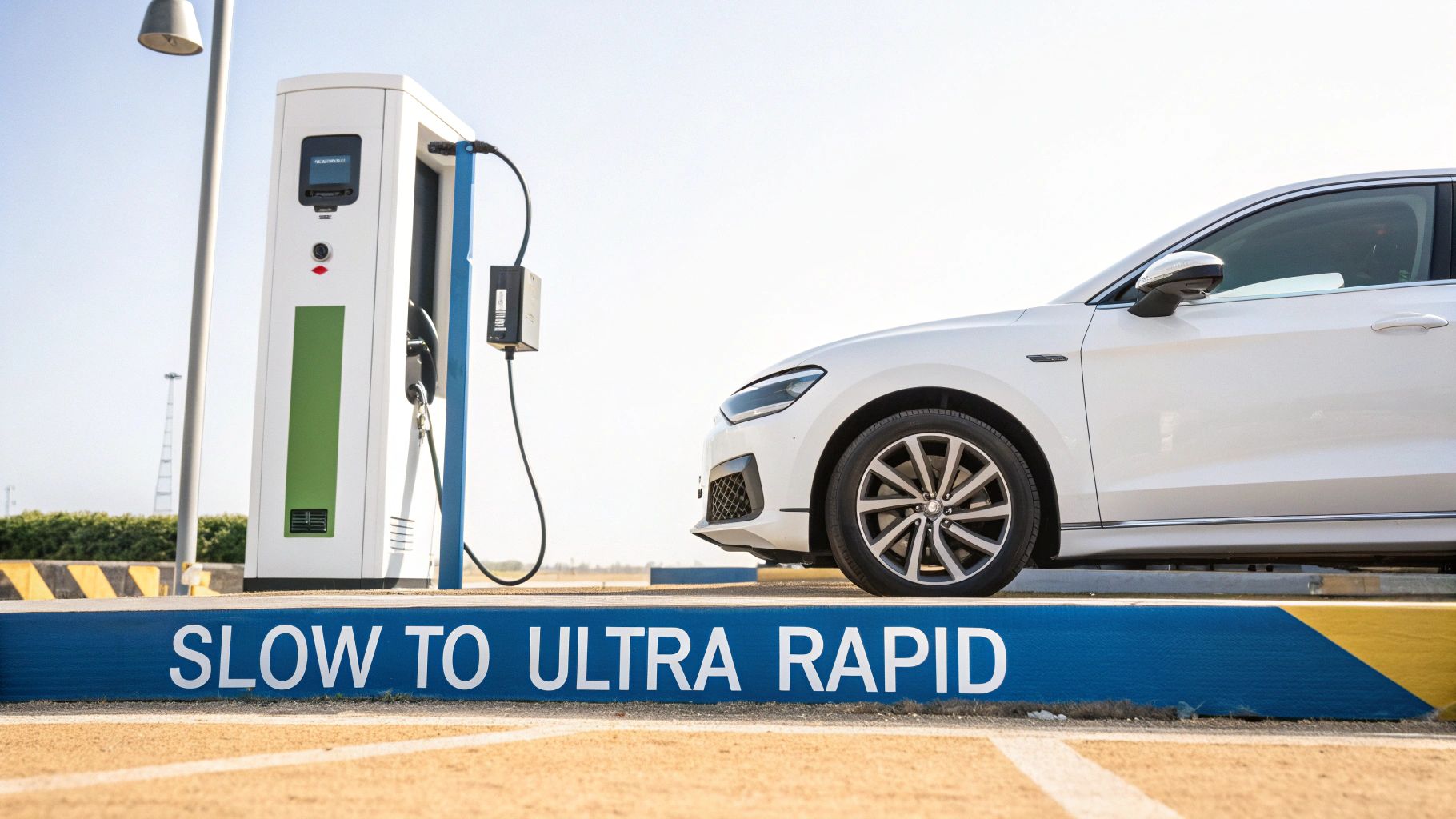
These mobile units are perfect for emergency roadside assistance when a driver runs out of battery, far from the nearest charger. They can also supply power at temporary events like festivals or in remote locations where permanent infrastructure just is not viable yet. For drivers, it offers huge peace of mind but for entrepreneurs it presents a substantial business opportunity.
How Mobile Charging Creates New Revenue
Mobile charging is far more than just a breakdown service. It is a flexible business model that can be adapted to serve a huge range of customers, creating multiple streams of income for an operator. The earning potential is significant for those who spot and serve key markets.
A single operator with one mobile unit can realistically earn between £40,000 and £80,000 per year . This income is typically generated through a mix of call-out fees for emergency jobs and a per-kilowatt-hour rate for the energy supplied. It is a model that provides immediate cash flow from on-demand work.
However, the most lucrative opportunities often come from long-term service contracts.
By securing contracts with fleet operators, car parks or business parks, a mobile charging business can establish a predictable and recurring revenue stream. This transforms the service from a reactive emergency response into a proactive energy management solution for commercial clients.
For instance, a business could offer scheduled top-ups for a fleet of delivery vans overnight, ensuring they start each day with a full charge without needing expensive depot grid upgrades. You can explore all the possibilities in our complete UK mobile EV charging service guide.
Who Benefits from Mobile Services?
The target market for a mobile charging business is incredibly diverse, extending well beyond stranded motorists. Each of these customer groups presents a unique opportunity for an operator to build a profitable enterprise.
- Fleet Managers: Companies with electric vans or cars need reliable charging. A mobile service can support depots during peak hours or provide on-site charging for vehicles that are not based at a central hub.
- Breakdown Recovery Services: Partnering with services like the AA or RAC allows operators to become the designated EV specialist for out-of-charge call-outs, tapping into an existing customer base.
- Event Organisers: Festivals, outdoor markets and corporate events often need temporary power solutions. Mobile charging units can power vendor stalls or offer a handy charging facility for attendees.
By using the right EV charger plug for each vehicle, a mobile unit becomes a truly versatile tool, capable of serving almost any car on the road. This flexibility is key to its financial success and its growing importance in our electric future.
Turning Mobile Charging Into a Profitable Business
Ever thought about turning a mobile EV charging service into a real, money-making business? It is more straightforward than you might think. The whole model is built on a simple, scalable idea: bringing the charge directly to the customer, wherever they happen to be.

Because it is an on-demand service, you can charge a premium. Most operators build their pricing around a flat call-out fee –often somewhere between £50 and £100 –plus a rate for every kilowatt-hour of electricity you deliver. This structure keeps you profitable even on smaller jobs and gives the business a solid financial footing from day one.
Finding Your Niche in the Market
Beyond just helping stranded drivers, there are several clever ways to build a steady income stream. One of the most popular is setting up subscription services for corporate clients. Think about fleet operators–they have a constant need to keep their vehicles topped up but often cannot afford expensive grid upgrades at their depots. You become their solution.
Another solid angle is partnering with property management companies. You can offer scheduled charging for residents in big apartment blocks or for tenants in business parks that were built without EV infrastructure in mind. This turns your service from a reactive one-off into a reliable, predictable source of income.
The real money is not just in emergency call-outs. It is in landing those service contracts. Securing a deal to charge a fleet of 20 electric vans or an entire residential complex is what transforms the business from a side hustle into a proactive and seriously profitable energy service.
What Is the Initial Investment?
Getting started does require some initial cash but it is far more accessible than trying to install a permanent charging station. Your main costs will be the mobile charging unit itself, a van big enough to house it and the right business insurance–especially public liability cover.
Once you are up and running, scaling the business is surprisingly quick. A single operator with one van can generate a very healthy income and you have the flexibility to add more vehicles to your fleet as demand picks up. The key to success is knowing who your customers are and having a reliable service with the right ev charger plug for any vehicle you might encounter.
Estimated Monthly Earnings for a Mobile Charger Operator
So, what could you actually earn? This table gives a rough idea of the potential monthly revenue for a single mobile charging unit. It is a simple illustration of how your income can grow as you take on more jobs, highlighting the strong earning potential of the business model.
| Service Level (Charges per day) | Average Fee per Charge (£) | Potential Monthly Revenue (£) | Notes |
|---|---|---|---|
| 2 (Part-Time/Starter) | £75 | £4,500 | Ideal for testing the market or as a side business. |
| 4 (Full-Time Operator) | £75 | £9,000 | A realistic target for a dedicated single operator. |
| 6 (High-Demand/Fleet Contracts) | £70 (Volume Discount) | £12,600 | Represents a business with established client contracts. |
As you can see, even at a modest level, the numbers are strong. And once you start securing regular contracts, the potential for a six-figure annual turnover from just one van is very real. It all comes down to building a reputation for reliability and being there when your clients need you most.
Your EV Charger Plug Questions Answered
Getting to grips with the world of EV charging can feel like learning a new language, with all its different plugs and standards. Let’s clear up some of the most common questions you might have about EV charger plugs here in the UK.
Can I Use an Adapter for the Wrong Plug Type?
Yes, but it is not always straightforward. For AC charging, it is fairly easy to find a Type 1 to Type 2 adapter cable . This is a lifesaver if you have an older EV and want to use the more common public charge points.
However, adapting between DC rapid charging standards like CCS and CHAdeMO is a whole different ball game. The sheer power levels and technical complexity involved mean that, for the average driver, it is just not a practical option. Your best bet is always to find a rapid charger that has the correct plug for your car right from the start.
Will My New EV Work with All UK Chargers?
The short answer is, almost certainly. Nearly every new electric car sold in the UK and Europe today comes factory-fitted with a Type 2 socket for AC charging and a CCS socket for DC rapid charging.
This combination gives you access to the vast majority of public chargers up and down the country. That said, it never hurts to double-check. Using a charging app to confirm a charger’s compatibility and see if it is working before you set off is always a smart move.
The standardisation around the CCS and Type 2 EV charger plug has been a major step forward for driver convenience. It has removed much of the guesswork from public charging and made long-distance travel much more reliable for new EV owners.
What Is the Difference Between AC and DC Charging?
The real difference is all about where the power conversion happens. The electricity from the grid is AC (Alternating Current) but your car's battery can only store DC (Direct Current). Something has to make the switch.
With AC charging—using a Type 2 plug—that conversion happens inside your car, using its on-board charger. This is a slower, more gradual process.
When you use a DC rapid charger with a CCS or CHAdeMO plug, the big charging station does all the heavy lifting. It converts the power to DC before it even enters your car. This allows it to bypass your car's slower internal equipment and pump energy directly into the battery at a much faster rate.
How Do I Start a Mobile Charging Business?
Starting a mobile EV charging business is an exciting venture that involves a few key steps. First up, you will need to research and purchase a certified mobile charging unit and find a suitable vehicle to carry it.
Next, it is time to create a solid business plan. Think about your target market, your pricing strategy and the areas you want to serve. Getting the right business insurance is also non-negotiable, especially public liability cover. Finally, you will need to market your service effectively to find your first clients, whether that is fleet operators, breakdown recovery services or individual EV drivers.
Ready to join the future of on-demand energy? ZAPME provides cutting-edge mobile EV charging solutions to help you start and scale a successful business. Explore our range of products and funding options at https://www.zapme.biz.

